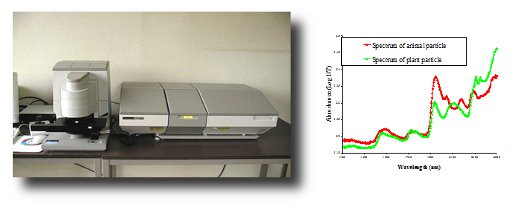NIRM (Near InfraRed Microscopy)
NIRM analysis, like light microscopy, is a particle-based method. Briefly explained a NIRM is a combination of a near infrared spectrometer associated to a conventional light microscope. The identification of PAPs relies on the analysis of the spectral absorbance of single animal particles exposed to a near infrared beam. Effectively, particles of a given nature deliver a unique NIR spectrum which is a signature reflecting its molecular composition.

The method does not imply any treatment of the sample. Particles of raw feed are simply spread on a sample plate and inserted under the infrared beam of the microscope. Spectra are recorded and automatically compared by chemometric analysis with data from libraries of spectra that are known to occur in compound feeds. NIRM, compared to light microscopy, can identify and segregate fish, mammals and poultry particles, but it cannot discriminate at species level.
Advantages
- Method is free from interpretation by an operator: no skills are requested
- Non-destructive method : other analysis can be performed on recovered particles for further identification
- Low levels of detection (<0.1%)
- Sediment from light microscopic method can also be analysed by NIRM
- Potential for quantification
- Automation possible of all spectral data treatment
Disadvantages
- Price of equipment
- Spectral database development or subscription
- Use of complexes statistical discriminant models
- Time consuming method (large number of spectra required before analysis)
- No animal species identification